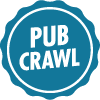
How I Plan a Book: Of Plotters and Pantsers
So this is actually the first part of a series I started over on my blog for my NaNoWriMo Bootcamp (feel free to join!). However, I wanted to share it here as well to make sure all the awesome Pub(lishing) Crawl readers don't miss out on something they might find helpful.
If you'd like to read other parts in the series, here is part 2 (Before I Start Drafting) and part 3 (Scene-Level Planning). And a 4th, final part will be coming on Monday. :)
Now, onto the introductory post!
I’m not a traditional outliner when it comes to writing my stories.
Actually, up until a month ago, I actually would have labeled myself a straight-up pantser (i.e. writing a novel entirely by the seat of my pants). But I realized that wasn’t really true.
I also realized that many of my so-called “panster” friends were actually outlining—they just didn’t see it that way.
And I also realized that many of my “outliner” friends were never actually adhering to their outlines—it was just a fluid roadmap.
In fact, it turns out that a lot of us authors are doing the exact same thing but labeling our method different things.
But a rose by any other name is still a rose, right?
The simple truth is we all plan to some extent or another, and much of that planning involves mulling for weeks at a time, jotting ideas down long-hand, chatting with trusted critique partners/friends, listening to music, and generally behaving like a serial killer (minus the killing part).
Now, I should quickly note that NOT ALL writers plan (though every published author I know does to some extent), and there must be some writers out there who create detailed outlines to which they strictly adhere (again, I know none of those writers). Yet what I tend to see most often are authors who know generally where they’re headed yet are willing to constantly let go of what they’d planned in favor of something that resonates better.
Likely you’ve heard the phrase, “headlights outlining” which refers to knowing just as far ahead in your story as your headlights can see—and then writing according to that sort of short-term outline.
But the truth is that most authors I know still have an ending in mind as they write–even if that “ending” will probably change a hundred times before they reach it or even if that “ending” is just a vague gut feeling they’re shooting toward. I would definitely qualify myself as a headlights outliner, BUT I also always have an idea of my midpoint and my ending before I start drafting.
Ultimately, “outlining” can come in many forms and you may not even recognize it as such—which is why I think so many “pansters” aren’t really pantsers at all.
Some more traditional forms of outlining:
Writing scene summaries on notecards
Making a bullet-point list of scenes
Writing a synopsis
Some non-traditional forms of outlining:
Writing any ideas on post-its, in notebooks, on scrap paper, in your phone, whatever
Making playlists that correspond to your story
Daydreaming scenes and snippets
Writing a terrible first draft of pure drivel and then rewriting based on what you discovered
Talking out ideas with a friend/CP
ANYTHING that involves thinking ahead in your story
Keep in mind that you might start 100% pantsing–pouring out dialogue and action without any clue where it’s going—but almost always, that approach will run out of steam. You’ll write the characters into a corner or realize you have absolutely no idea what happens next. Then, inevitably, you’ll either abandon the project (that was TOTALLY me in my early-early days of writing) or be forced to start planning so you know what to write next.
Also consider that you might start 100% outlining with something that you think is the most perfect organization of scenes and plot points. But then, as you write, you find it harder and harder to keep your characters on the train track you’d designed for them—maybe the actions you’d planned for them to make just don’t feel natural anymore. Or the love interest you’d crafted holds zero interest for you. Whatever the situation, many people come up against an outline that makes each word start to feel more and more forced. And yet again, you’ll either abandon the project or be forced to toss the outline and start writing what feels natural.
I have been in both situations many times—a despair-filled cave of not planning enough and a depressing pit of being stuck with an outline I hate. It has only been with my most recent few projects that I finally started to understand how I operate best—what sort of planning I need to do in order to write a first draft as hiccup-free as I can make it.
You tell me: Have you firmly labeled yourself as a panster or outliner? Do you think maybe you could actually fit into both camps a bit?






